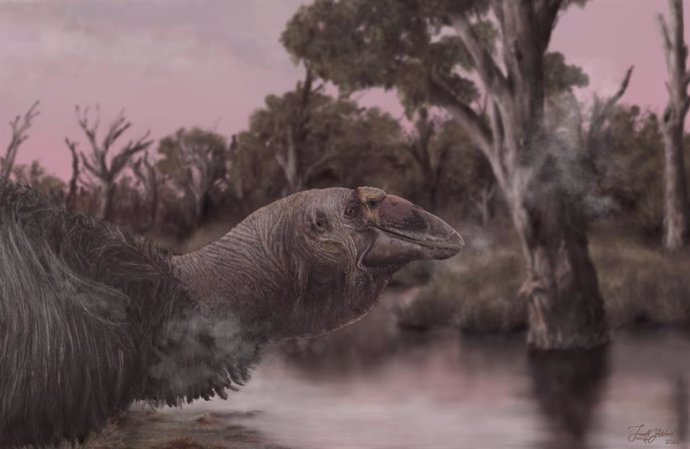An artistic reconstruction of the life of Genyornis newtoni, the last of the dromornithids, at the water’s edge. – JACOB C. BLOKLAND (FLINDERS UNIVERSITY).
June 4 () –
After 128 years of exploration, fossil excavation and research, the skull of a ancient giant and charismatic species from Australia: Genyornis newtoni.
The only previously known skull of this species, reported in 1913, was badly damaged and, as little of the original bone remained, Not much could be deduced about the skull of this species. Now, with these new fossils, excavated from the dry, saline beds of Lake Callabonna, a remote region of inland South Australia, lead author Phoebe McInerney, of Flinders University, and her colleagues can reveal what this species was really like. , resembling a giant goose.
The fossils, discovered during Flinders University Paleontology Laboratory field trips to Lake Callabonna in 2019, were associated with almost complete body fossils, confirming the attribution of the skull to Genyornis newtoni, a species that became extinct about 45,000 years ago. The description of the structure of this remarkable skull, now published in the journal Historical Biology, provided researchers with the basis to explore the ecology, functional morphology and evolutionary relationships of these giant birds.
230 KILOS WEIGHT
As expected from a giant of this size (approximately 230 kg), about five times the weight of the southern cassowary, the skull of Genyornis newtoni was far from ordinary, with a huge braincase, large upper and lower jaws, and an unusual helmet on top of the head. The upper beak, in particular, displayed a striking morphology, setting this bird apart from even its closest relatives, which are otherwise quite similar.
“Genyornis newtoni had a high and mobile upper jaw like that of a parrot but shaped like a goose, a wide mouth, a great bite force and the ability to crush soft plants and fruits with the palate” says Flinders University researcher Phoebe McInerney, it’s a statement.
Some aspects of the skull also showed undeniable and complex similarities with those of divergent lineages of early waterfowl, the South American whooping geese and, a little closer to home, the Australian magpie goose.
“The exact relationships of Genyornis within this group have been complicated to unravel, however, with this new skull we have begun to put together the puzzle that shows, simply, that this species is a giant goose“, says.
“We were particularly excited to discover the first fossil upper beak of Genyornis, for the first time we were able to put a face on this bird, one very different to any other bird, but like a goose,” says co-author Dr Trevor Worthy.
Evaluating the morphology of the skull also gave the researchers an in-depth look at how the head would have functioned by making an assessment of the muscles and movement available at each of the joints.
Jacob Blokland, co-author of the article, says: “The shape of a bone and the structures that make it up are related in part to the soft tissues that interact with them, like muscles and ligamentsand their binding sites or passages.
“Using modern birds as comparators, we can put flesh back on fossils and bring them back to life,” says Blokland, who has brought Genyornis newtoni back to life through a scientifically accurate reconstruction.
Additionally, this study found that these giant birds had several unusual adaptations for aquatic habitats, allowing them to protect their ears and throat from water entry. when the head was submerged.
These adaptations further support that Genyornis is nothing more than a giant prehistoric goose and are potentially linked to its extinction, as freshwater bodies in northern South Australia They are now mainly salt lakes.
With this skull, researchers now know much more than ever about Genyornis newtoni, having gained a greater understanding of these birds that once roamed widely across outback Australia and their eventual demise.
The new article has been published in the magazine Historical Biology.















Add Comment